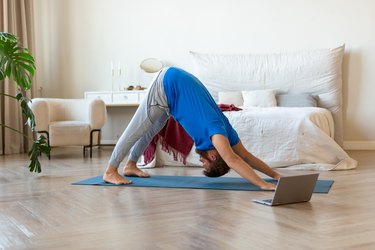

While some mornings have you cutting corners, like abbreviating a relaxing bath for a speedy shower, there are certain things you should never skip when the sun rises. Like brushing your teeth and eating a balanced breakfast, a morning mobility routine should rank on your list of nonnegotiable to-dos in the a.m.
"Mobility training is just as important as strength or cardiovascular training," says Megan Humphrey, a NASM-certified personal trainer and Orangetheory coach. "Mobility training's main role is to warm up the tissue that surrounds joints to allow for unrestricted and stress-free motion of the body."
Video of the Day
Doing a mobility flow first thing can set you up for a successful day. Focused mobility work not only centers and grounds you (enhancing your mind-body connection), but it also prepares your body for daily physical activities, like picking up grocery bags, getting into the car or climbing the stairs, Humphrey says.
"By priming our bodies and minds for activity and teaching our joints the correct movement patterns, we can reduce the risk of injury from joint and tissue dysfunction," Humphrey explains.
Mobility training also improves circulation to our organs and tissues, Humphrey adds. Which can be just as energizing as your cup of joe, helping your heart, lungs and brain function at peak performance, she explains.
If you're thinking how the heck am I supposed to schedule a mobility routine into my packed morning? We got you. Set up your coffee (or tea) pot and perform this 5-minute mobility routine, which you can do while your perk percolates. You'll be loose and limber by the time you start smelling the sweet aroma of your favorite brew.
5-Minute Morning Mobility Routine
With only three movements, this quick but effective mobility sequence will wake up the joints in your lower and upper body, from your ankles to your neck. Do it every morning (and/or as a pre-workout warm-up) for maximum range of motion benefits.
1. Child’s Pose to Downward Facing Dog
"Adding a compound mobility movement like this one works the sagittal movement plane, promoting forward-backward motion and improved blood circulation throughout the body," Humphrey says.
- Start kneeling with your knees slightly wider than hip-width distance apart. Send your hips back, allowing your heels to touch your glutes, or as close to touching as possible.
- Lean your chest toward the floor in between your legs, and extend your arms in front of you with your palms planted on the floor. Let your head hang heavy in between your arms (or allow your forehead to touch the ground if that range of motion is available for you).
- Start incorporating breath work: Breathe in for four counts through your nose, hold one count, and exhale through your nose for four counts.
- Shift forward to a tabletop position with your knees stacked directly under your hips and your wrists stacked directly under the elbows and shoulders. Maintain a tiny, micro bend in your elbows to protect the joints.
- Tuck your toes and push your glutes back to the upper portion of the wall behind you by straightening your legs, and again, add a slight bend in the knees to protect the joints. Extend your arms to help propel your glutes up. This position is called downward facing dog.
- In downward dog, take three or so deep breaths (or incorporate the 4-1-4 breathing method as mentioned above).
- Return to the tabletop position and sit back on your heels to return to child’s pose.
- Repeat this cycle fluidly for 3 reps.
2. Heel Raise to Toe Raise
Prioritizing ankle mobility is majorly important. Limber ankles are linked to better balance, which has a positive downstream effect on your overall physical performance.
Here's why: "Your ankles provide balance in the sagittal, transverse and lateral planes, and balance increases stability when walking, running and weightlifting, as well as reduces the risk of falling," Humphrey says.
- Standing next to a wall, place one hand on the wall for stability.
- Stand up tall with a neutral posture by slightly tucking your tailbone.
- Rock forward onto your tiptoes, or as far on the balls of your feet as possible.
- Rock backward to your heels, aiming to get your toes lifted off the ground.
- That’s 1 rep. Do 2 sets of 10 reps with 15 seconds of rest in between.
3. Neck Roll
Incorporating neck mobility into your daily routine is a great way to brace your joints and muscles in the base of your neck for the day ahead. "The sternocleidomastoid muscles in our necks take the brunt of the tension when picking up, grabbing or pulling things up from off the ground," Humphrey says.
- Start in a seated or standing position.
- Drop one ear toward your shoulder, finding a stretch in the side of the neck (i.e., the sternocleidomastoid muscles).
- Gently start rolling your head around by dropping your chin to your chest and around to the other side. Only roll your neck to the range of motion that doesn't cause pain, just a gentle stretch.
- Repeat at a slow and steady pace, back and forth for 5 rolls.
Related Reading